Peter Jin
Driving Safety Prediction and Safe Route Mapping Using In-vehicle and Roadside Data
Sep 12, 2022



Abstract:Risk assessment of roadways is commonly practiced based on historical crash data. Information on driver behaviors and real-time traffic situations is sometimes missing. In this paper, the Safe Route Mapping (SRM) model, a methodology for developing dynamic risk heat maps of roadways, is extended to consider driver behaviors when making predictions. An Android App is designed to gather drivers' information and upload it to a server. On the server, facial recognition extracts drivers' data, such as facial landmarks, gaze directions, and emotions. The driver's drowsiness and distraction are detected, and driving performance is evaluated. Meanwhile, dynamic traffic information is captured by a roadside camera and uploaded to the same server. A longitudinal-scanline-based arterial traffic video analytics is applied to recognize vehicles from the video to build speed and trajectory profiles. Based on these data, a LightGBM model is introduced to predict conflict indices for drivers in the next one or two seconds. Then, multiple data sources, including historical crash counts and predicted traffic conflict indicators, are combined using a Fuzzy logic model to calculate risk scores for road segments. The proposed SRM model is illustrated using data collected from an actual traffic intersection and a driving simulation platform. The prediction results show that the model is accurate, and the added driver behavior features will improve the model's performance. Finally, risk heat maps are generated for visualization purposes. The authorities can use the dynamic heat map to designate safe corridors and dispatch law enforcement and drivers for early warning and trip planning.
Regret Minimization for Partially Observable Deep Reinforcement Learning
Oct 25, 2018



Abstract:Deep reinforcement learning algorithms that estimate state and state-action value functions have been shown to be effective in a variety of challenging domains, including learning control strategies from raw image pixels. However, algorithms that estimate state and state-action value functions typically assume a fully observed state and must compensate for partial observations by using finite length observation histories or recurrent networks. In this work, we propose a new deep reinforcement learning algorithm based on counterfactual regret minimization that iteratively updates an approximation to an advantage-like function and is robust to partially observed state. We demonstrate that this new algorithm can substantially outperform strong baseline methods on several partially observed reinforcement learning tasks: learning first-person 3D navigation in Doom and Minecraft, and acting in the presence of partially observed objects in Doom and Pong.
A Novel Domain Adaptation Framework for Medical Image Segmentation
Oct 11, 2018

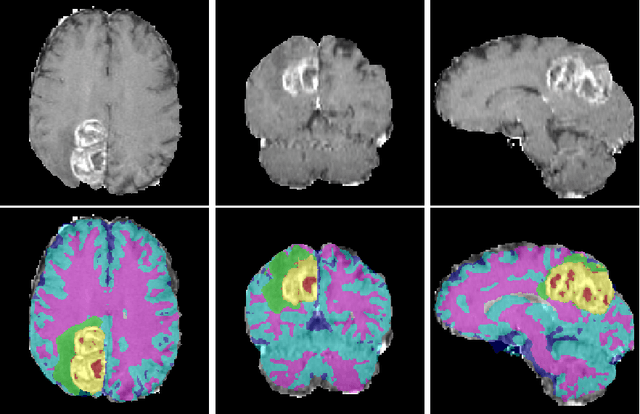

Abstract:We propose a segmentation framework that uses deep neural networks and introduce two innovations. First, we describe a biophysics-based domain adaptation method. Second, we propose an automatic method to segment white and gray matter, and cerebrospinal fluid, in addition to tumorous tissue. Regarding our first innovation, we use a domain adaptation framework that combines a novel multispecies biophysical tumor growth model with a generative adversarial model to create realistic looking synthetic multimodal MR images with known segmentation. Regarding our second innovation, we propose an automatic approach to enrich available segmentation data by computing the segmentation for healthy tissues. This segmentation, which is done using diffeomorphic image registration between the BraTS training data and a set of prelabeled atlases, provides more information for training and reduces the class imbalance problem. Our overall approach is not specific to any particular neural network and can be used in conjunction with existing solutions. We demonstrate the performance improvement using a 2D U-Net for the BraTS'18 segmentation challenge. Our biophysics based domain adaptation achieves better results, as compared to the existing state-of-the-art GAN model used to create synthetic data for training.
SqueezeNext: Hardware-Aware Neural Network Design
Aug 27, 2018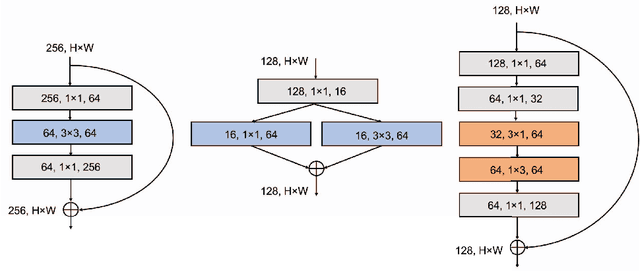
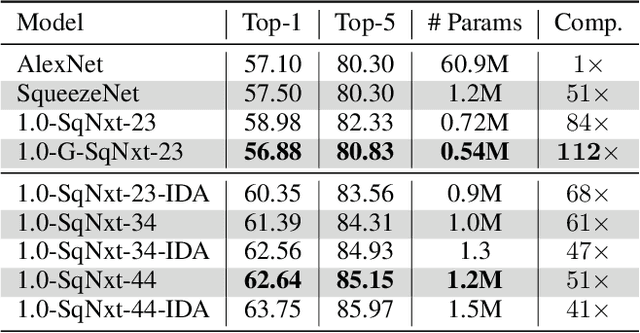

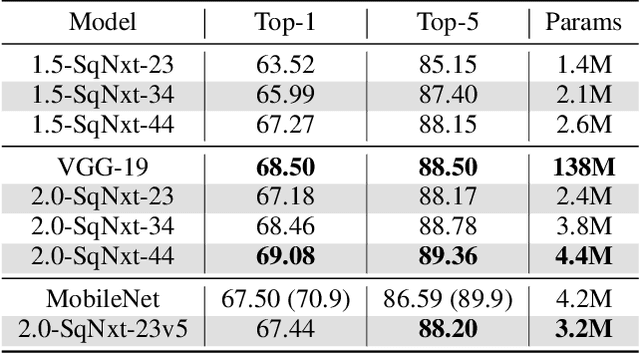
Abstract:One of the main barriers for deploying neural networks on embedded systems has been large memory and power consumption of existing neural networks. In this work, we introduce SqueezeNext, a new family of neural network architectures whose design was guided by considering previous architectures such as SqueezeNet, as well as by simulation results on a neural network accelerator. This new network is able to match AlexNet's accuracy on the ImageNet benchmark with $112\times$ fewer parameters, and one of its deeper variants is able to achieve VGG-19 accuracy with only 4.4 Million parameters, ($31\times$ smaller than VGG-19). SqueezeNext also achieves better top-5 classification accuracy with $1.3\times$ fewer parameters as compared to MobileNet, but avoids using depthwise-separable convolutions that are inefficient on some mobile processor platforms. This wide range of accuracy gives the user the ability to make speed-accuracy tradeoffs, depending on the available resources on the target hardware. Using hardware simulation results for power and inference speed on an embedded system has guided us to design variations of the baseline model that are $2.59\times$/$8.26\times$ faster and $2.25\times$/$7.5\times$ more energy efficient as compared to SqueezeNet/AlexNet without any accuracy degradation.
Integrated Model, Batch and Domain Parallelism in Training Neural Networks
May 16, 2018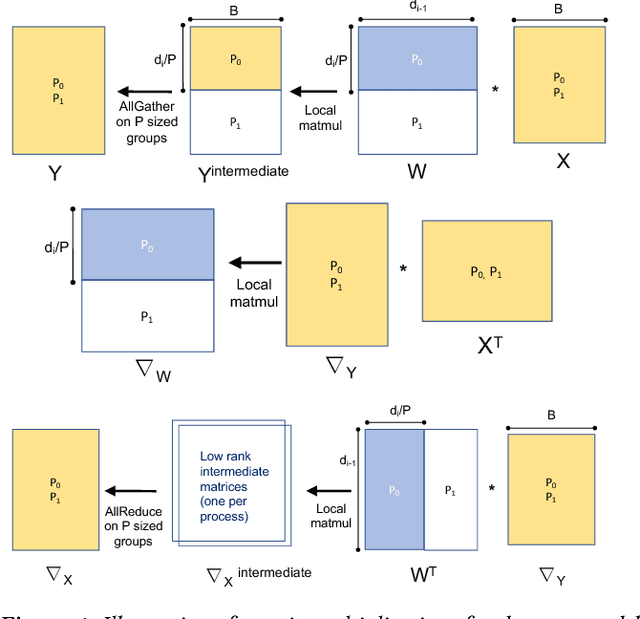
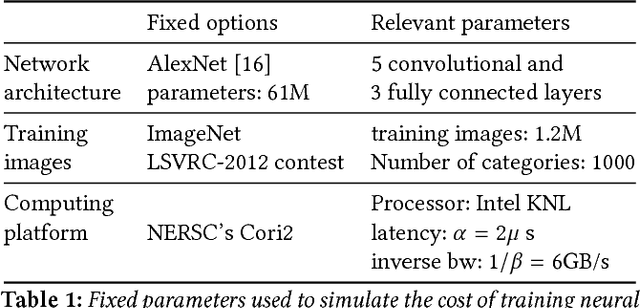
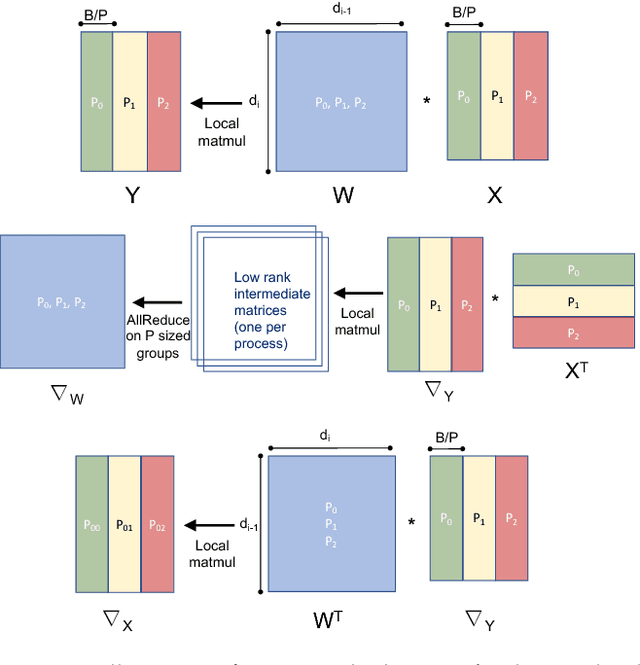
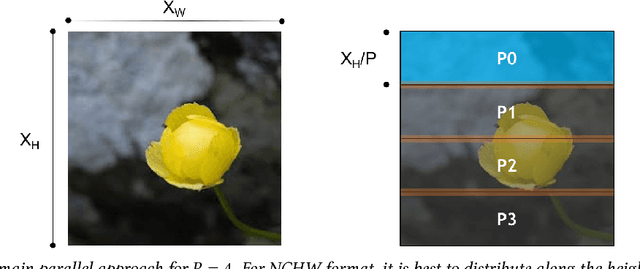
Abstract:We propose a new integrated method of exploiting model, batch and domain parallelism for the training of deep neural networks (DNNs) on large distributed-memory computers using minibatch stochastic gradient descent (SGD). Our goal is to find an efficient parallelization strategy for a fixed batch size using $P$ processes. Our method is inspired by the communication-avoiding algorithms in numerical linear algebra. We see $P$ processes as logically divided into a $P_r \times P_c$ grid where the $P_r$ dimension is implicitly responsible for model/domain parallelism and the $P_c$ dimension is implicitly responsible for batch parallelism. In practice, the integrated matrix-based parallel algorithm encapsulates these types of parallelism automatically. We analyze the communication complexity and analytically demonstrate that the lowest communication costs are often achieved neither with pure model nor with pure data parallelism. We also show how the domain parallel approach can help in extending the theoretical scaling limit of the typical batch parallel method.
* 11 pages
Shift: A Zero FLOP, Zero Parameter Alternative to Spatial Convolutions
Dec 03, 2017



Abstract:Neural networks rely on convolutions to aggregate spatial information. However, spatial convolutions are expensive in terms of model size and computation, both of which grow quadratically with respect to kernel size. In this paper, we present a parameter-free, FLOP-free "shift" operation as an alternative to spatial convolutions. We fuse shifts and point-wise convolutions to construct end-to-end trainable shift-based modules, with a hyperparameter characterizing the tradeoff between accuracy and efficiency. To demonstrate the operation's efficacy, we replace ResNet's 3x3 convolutions with shift-based modules for improved CIFAR10 and CIFAR100 accuracy using 60% fewer parameters; we additionally demonstrate the operation's resilience to parameter reduction on ImageNet, outperforming ResNet family members. We finally show the shift operation's applicability across domains, achieving strong performance with fewer parameters on classification, face verification and style transfer.
 Add to Chrome
Add to Chrome Add to Firefox
Add to Firefox Add to Edge
Add to Edge